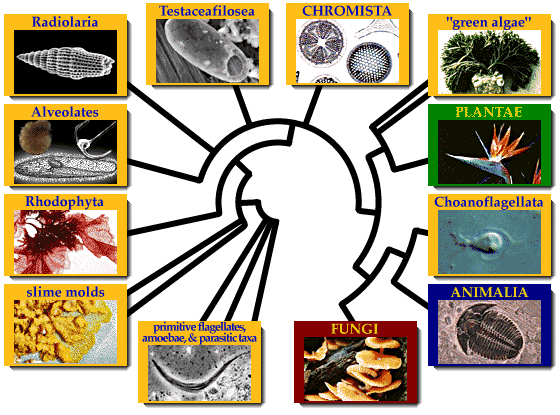



Eukaryota: Systematics
Move deeper into the systematics of eukaryotic groups by selecting one of the boxes containing a picture!




Move deeper into the systematics of eukaryotic groups by selecting one of the boxes containing a picture!

In recent years, eukaryotes have been broken down into four kingdoms: animals, plants, fungi, and protists or protoctists. The first three kingdoms are well-defined monophyletic groups, but the "Kingdom Protista" is not monophyletic; it contains organisms which are more closely related to members of other kingdoms than they are to other protists. It's also defined on the absence of characters (i.e. no complex development from embryos, no extensive cell differentiation, etc.), which is considered poor form.
Recent studies of protist DNA and ultrastructure has shown that the protists are far more diverse than had been previously expected; they probably should be classified in several kingdom-level taxa. We retain the word "protist" as a convenient term to mean "eukaryote that isn't a plant, animal, or fungus."
In this cladogram and in all other eukaryote cladograms, we use the following color scheme: animals are blue, fungi are dark red, plants are green, and protists are yellow. Bright red boxes indicate a taxon of uncertain affinities. Click here for more information about conventions used in our exhibits format.
For more information on protists:
We recommend the
Protist Image Database at the University of Montreal as a resource for those
interested in protist biology. Rudolph
Leuckart's 19th century zoological wall charts also include a number of
protist and animal images; the taxonomy is a bit archaic, but the artwork is
classic.
The Tree of Life includes current information of the relationships of the major eukaryote groups.


